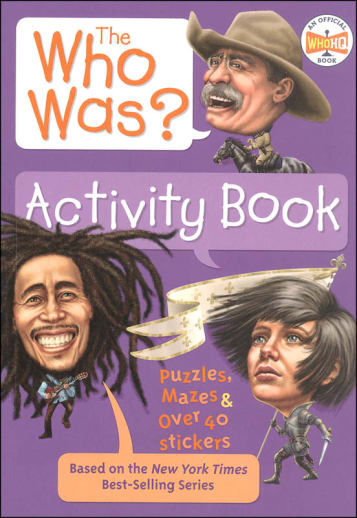Laugh at the black and white caricatures, draw, complete varied puzzles and learn tantalizing snippets about famous politicians, writers, inventors, scientists, humanitarians, athletes, and entertainers. Examine braille; complete word searches and mazes; get your own pirate name, and more! A companion piece for the bestselling Who Was series, but engaging and fact-filled all on its own! Includes an answer key and 44 caricature stickers. 5 1/4" x 7.5", 112 pgs, pb. ~ Ruth
Who Was? Activity Book
SKU
067749
ISBN
9781524789978
Grade 3-7
Neutral
Non-Consumable
These icons are designed to help you quickly understand and learn important information about our products.
Teaching Method
Traditional
Teacher-centered curriculum commonly used in classrooms that may include a text, teacher manual, tests, etc.
Charlotte Mason
A methodology based on the work of a 19th century educator who maintained that children learn best from literature (Living Books), not textbooks.
Classical
A methodology based on the Latin Trivium (three stages of learning), including the grammar stage (memorization and facts), logic stage (critical thinking), and rhetoric stage (developing/defending ideas).
Unit Study
A thematic or topical approach centered around one topic that integrates multiple subject areas.
Montessori (Discovery)
A methodology based on the work of a 20th century educator that emphasizes student and sensory-driven discovery learning and real-life applications.
Other
Other methodologies
Religious Content
Secular
Contains content contrary to common Christian beliefs (i.e. evolution).
Neutral
Avoids religious or theoretical topics or presents multiple viewpoints without preference.
Christian/Religious
Faith-based or including instructional religious content.
Learning Modality
Auditory
Learns through listening, talking out loud or reading out loud.
Visual
Learns through seeing, prefers written instructions and visual materials.
Kinesthetic/Tactile (Hands-On)
Learns through moving, doing and touching.
Multi-Sensory
Curriculum that employ a variety of activities/components.
Presentation
Sequential
Curriculum progresses through well-defined learning objectives. Emphasizes mastery before moving to the next topic.
Spiral
Topics and concepts are repeated from level to level, adding more depth at each pass and connecting with review.
Conceptual/Topical
Focus is on the “why,” often with a unifying concept as well as specific skills; coverage may be broader.
Teacher Involvement
Low Teacher Involvement
Student-led materials; parent acts as a facilitator.
Medium Teacher Involvement
A mix of teacher-led time and independent student work.
High Teacher Involvement
Teacher-led lessons; may utilize discussions, hands-on activities and working together.
Additional Materials Required
No other materials needed
Everything you need is included.
Other Materials Required
There are additional required resources that are a separate purchase.
Other Materials Optional
There are additional resources mentioned or recommended but are not absolutely necessary.
Consumable
Consumable
Designed to be written in; not reusable.
Non-Consumable
Not designed to be written in; reusable.
Our Price
$7.99 $7.99 $6.25
Rainbow Savings: $1.74
Description
Publisher's Description of Who Was? Activity Book
The Who Was? Activity Book, sized down to match the other Who HQ titles, now has even more pages of puzzles, mazes, quizzes, and brain-busting challenges, all based on the New York Times best-selling Who Was? series.
Can you paint like Picasso? Write like Shakespeare? Solve a puzzle as fast as Einstein? Go head-to-head with your favorite Who Was? characters and leave your mark on history with this fun and exciting activity book.
Includes three pages of full-color stickers!
Category Description for Who Was? (Who HQ) Biographies
These biographies highlight the lives of famous people in an engaging chapter book format with caricature-style cover art. The easy-to-read stories are captivating and black and white illustrations are featured on every page. From birth to death (or current times), many details of the people’s lives are given. Though the stories are told in a fun way with many illustrations, they still give much historical information about each person and the world around them. They are great for introducing historical figures to younger students or giving a general overview of the person for older students. A timeline of the person’s life events and other world events is included in each book. Approx. 100 pgs.
Details
| Product Format: | Binder |
|---|---|
| Grades: | 3-7 |
| Brand: | Penguin Workshop |
| ISBN: | 9781524789978 |
| Length in Inches: | 10.875 |
| Width in Inches: | 8.5 |
| Height in Inches: | 0.375 |
| Weight in Pounds: | 0.8 |
Videos
Reviews

